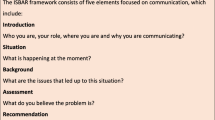Abstract
In 2012, the ACGME supplemented the core competencies with outcomes-based milestones for resident performance within the six competency domains. These milestones address the knowledge, skills, abilities, attitudes, and experiences that a resident is expected to progress through during the course of training. Even prior to the initiation of the milestones, there was a paucity of EM literature addressing the remediation of problem resident behaviors and there remain few readily accessible tools to aid in the implementation of a remediation plan. The goal of the “Problem Resident Behavior Guide” is to provide specific strategies for resident remediation based on deficiencies identified within the framework of the EM milestones. The “Problem Resident Behavior Guide” is a written instructional manual that provides concrete examples of remediation strategies to address specific milestone deficiencies. The more than 200 strategies stem from the experiences of the authors who have professional experience at three different academic hospitals and emergency medicine residency programs, supplemented by recommendations from educational leaders as well as utilization of valuable education adjuncts, such as focused simulation exercises, lecture preparation, and themed ED shifts. Most recommendations require active participation by the resident with guidance by faculty to achieve the remediation expectations. The ACGME outcomes-based milestones aid in the identification of deficiencies with regards to resident performance without providing recommendations on remediation. The Problem Resident Behavior Guide can therefore have a significant impact by filling in this gap.
Similar content being viewed by others
References
The Emergency Medicine Milestone Project (2012) The accreditation council for graduate medical education and the America board of emergency medicine
American Board of Internal Medicine (1999) Association of program directors in internal medicine (APDIM)’s chief residents’ workshop on problem residents
Torbeck L, Canal DF (2009) Remediation practices for surgery residents. Am J Surg 197(3):397–402
Yao DC, Wright SM (2001) The challenge of problem residents. J Gen Intern Med 16(7):486–492
Sullivan C et al (2011) Emergency medicine directors’ perceptions on professionalism: a council of emergency medicine residency directors survey. Acad Emerg Med 18(Suppl 2):S97–S103
Katz ED et al (2010) Guiding principles for resident remediation: recommendations of the CORD remediation task force. Acad Emerg Med 17(Suppl 2):S95–S103
Author information
Authors and Affiliations
Corresponding author
Ethics declarations
Conflict of interest
The authors declare that they have no conflict of interest.
Statement of human and animal rights
This article does not contain any studies with human participants or animals performed by any of the authors.
Informed consent
For this type of study formal consent is not required.
Electronic supplementary material
Below is the link to the electronic supplementary material.
Rights and permissions
About this article
Cite this article
Williamson, K., Quattromani, E. & Aldeen, A. The problem resident behavior guide: strategies for remediation. Intern Emerg Med 11, 437–449 (2016). https://doi.org/10.1007/s11739-015-1367-5
Received:
Accepted:
Published:
Issue Date:
DOI: https://doi.org/10.1007/s11739-015-1367-5




